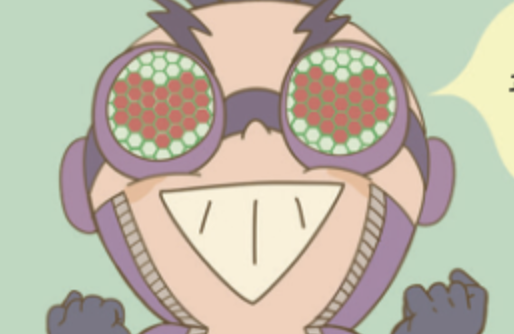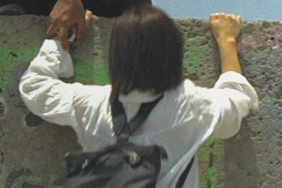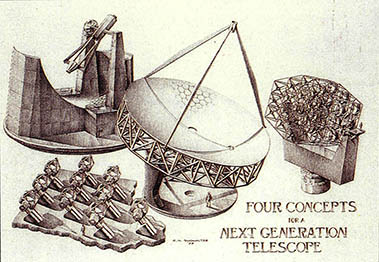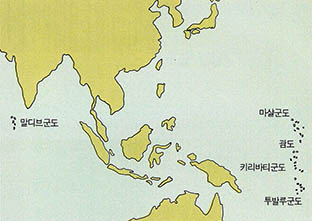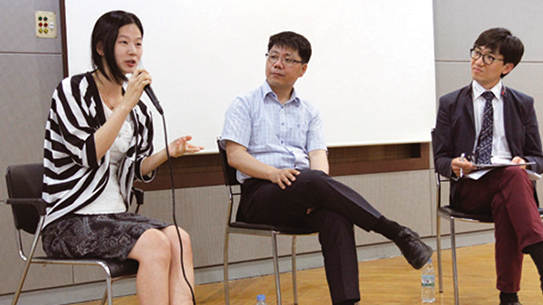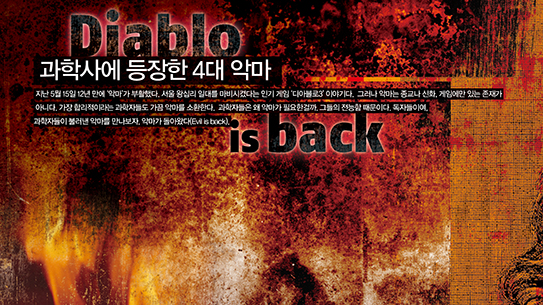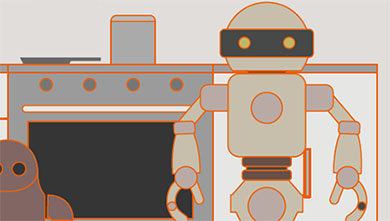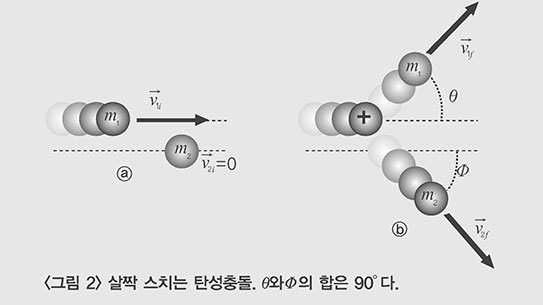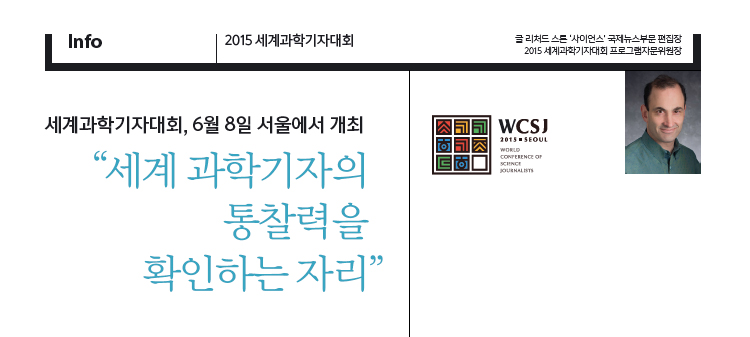
한국은 지구상에 현존하는 유일한 분단국입니다. 수십 년 동안 지속된 이 정치적 지리적 비극은 과학언론과 전혀 관계가 없어 보입니다. 그런데, 과연 그럴까요?
과학기자의 중요한 역할 중 하나는, 얼핏 보기에 과학언론의 영역이 아닌 것 같은 사실에서 과학적인 면을 발견하는 것입니다. 북한의 핵을 예로 들면, 영변 핵시설에서 사용된 연료에서 얼마 만큼의 플루토늄이 재처리되고 있나, 북한은 어떻게 긴 시간 동안 우라늄을 숨길 수 있었나, 핵폭탄을 소형화해서 대포동 미사일에 탑재하기 위해 어떤 기술적인 문제를 해결하려고 하는가 등과 같은 문제를 정치부 소속의 동료 기자들에게만 맡겨둘 것이 아니라 우리 과학기자들도 다뤄야 합니다.
한-중 국경에 위치한 백두산은 한국 역사에서 민족의 성지입니다. 그런데 10세기 경에 있었던 백두산 화산 분출이 지난 1만 년을 통틀어 세계에서 가장 커다란 규모였다는 것을 알고 계십니까? 환태평양 화산대에서 멀리 떨어진 화산이 어떻게 그렇게 큰 파급력을 가지고 있는가는 아직도 과학적으로 설명할 수 없는 미제로 남아 있습니다. 이 숙제를 풀기 위해서 북한과 서방의 과학자들 간의 꾸준한 연구협력이 진행 중입니다.
앞에서 말씀드린 과학적 주제들의 공통점은 엠바고가 명시된 보도자료에서 찾아볼 수 없다는 것입니다. 독자를 대상으로 새로운 기사를 쓰기 위해서는 잘 차려진 밥상이 아니라 날 것인 상태에서 취재원을 확보하고 정보를 캐내야 합니다. 우리 모두 다 알다시피, 기사거리를 찾고 기사를 보도하기 위해 동분서주하는 것은 기자라는 직종의 본질입니다.
오는 6월, 한국의 수도 서울에서 열리는 제9회 세계과학기자대회에 여러분을 초대합니다. 이 행사에 참가해서 새로운 것을 배우는 기회를 누리시기 바랍니다. 북한에 관심이 있으시면, 북한의 과학자들을 세계 과학 커뮤니티의 일원으로 통합하려는 노력을 소개하는 과학외교 세션에 오시기 바랍니다. 과학언론이 서아프리카에서 발생한 에볼라를 어떻게 보도했는지가 궁금하시면, 현장을 취재한 동료 기자들이 발표하는 전체 세션을 눈여겨보시기 바랍니다. 노벨상 수상자와 퓰리처상 수상자가 기조강연을 하고, 또 다른 세션에서는 첨단 분야를 연구하는 한국 과학자들이 최신 연구 결과를 발표합니다. 저는 2015 세계과학기자대회 프로그램자문위원회 위원장으로서 여러분께 약속드립니다. 이번 행사에 오셔서 각자가 가지신 예리한 관찰력을 발휘하신다면, 여러분은 스스로를 더 좋은 기자로 만들 '통찰력'을 가지고 집으로 돌아가게 될 것입니다.
번역 김은성 2015세계과학기자대회 조직위원회 총괄위원장
과학기자의 중요한 역할 중 하나는, 얼핏 보기에 과학언론의 영역이 아닌 것 같은 사실에서 과학적인 면을 발견하는 것입니다. 북한의 핵을 예로 들면, 영변 핵시설에서 사용된 연료에서 얼마 만큼의 플루토늄이 재처리되고 있나, 북한은 어떻게 긴 시간 동안 우라늄을 숨길 수 있었나, 핵폭탄을 소형화해서 대포동 미사일에 탑재하기 위해 어떤 기술적인 문제를 해결하려고 하는가 등과 같은 문제를 정치부 소속의 동료 기자들에게만 맡겨둘 것이 아니라 우리 과학기자들도 다뤄야 합니다.
편집자 주 세계 과학기자와 과학저술가의 축제인 제9회 세계과학기자대회가 6월 8일부터 12일까지 서울 코엑스에서 열린다. 국제적인 감각을 갖춘 세계 과학기자, 과학자들이 어우러져 자신만의 노하우와 안목, 고민을 함께 나눌 수 있는 귀한 자리다. 행사의 프로그램위원장인 리처드 스톤 '사이언스' 국제뉴스부문 편집장이 한국과학기자협회보에 보내온 기고문을 필자 및 대회 조직위원회의 허락 하에 소개한다
1990년대 중반에 북한에서는 기아로 수많은 사람들이 사망했고, 수백만 명이 영양실조와 감염에 노출됐습니다. 이 재해에서 비롯된 가장 큰 불행이 폐결핵입니다. 북한의 폐결핵 감염률이 대폭 증가하면서 불충분한 치료로 인해 일반적인 항생제가 듣지 않는 다제내성 폐결핵이 급증했습니다. 오늘날 공공 보건의 무덤이라 할 이 사태가 남한이나 중국으로 확산될 가능성도 배제할 수 없습니다.한-중 국경에 위치한 백두산은 한국 역사에서 민족의 성지입니다. 그런데 10세기 경에 있었던 백두산 화산 분출이 지난 1만 년을 통틀어 세계에서 가장 커다란 규모였다는 것을 알고 계십니까? 환태평양 화산대에서 멀리 떨어진 화산이 어떻게 그렇게 큰 파급력을 가지고 있는가는 아직도 과학적으로 설명할 수 없는 미제로 남아 있습니다. 이 숙제를 풀기 위해서 북한과 서방의 과학자들 간의 꾸준한 연구협력이 진행 중입니다.
앞에서 말씀드린 과학적 주제들의 공통점은 엠바고가 명시된 보도자료에서 찾아볼 수 없다는 것입니다. 독자를 대상으로 새로운 기사를 쓰기 위해서는 잘 차려진 밥상이 아니라 날 것인 상태에서 취재원을 확보하고 정보를 캐내야 합니다. 우리 모두 다 알다시피, 기사거리를 찾고 기사를 보도하기 위해 동분서주하는 것은 기자라는 직종의 본질입니다.
오는 6월, 한국의 수도 서울에서 열리는 제9회 세계과학기자대회에 여러분을 초대합니다. 이 행사에 참가해서 새로운 것을 배우는 기회를 누리시기 바랍니다. 북한에 관심이 있으시면, 북한의 과학자들을 세계 과학 커뮤니티의 일원으로 통합하려는 노력을 소개하는 과학외교 세션에 오시기 바랍니다. 과학언론이 서아프리카에서 발생한 에볼라를 어떻게 보도했는지가 궁금하시면, 현장을 취재한 동료 기자들이 발표하는 전체 세션을 눈여겨보시기 바랍니다. 노벨상 수상자와 퓰리처상 수상자가 기조강연을 하고, 또 다른 세션에서는 첨단 분야를 연구하는 한국 과학자들이 최신 연구 결과를 발표합니다. 저는 2015 세계과학기자대회 프로그램자문위원회 위원장으로서 여러분께 약속드립니다. 이번 행사에 오셔서 각자가 가지신 예리한 관찰력을 발휘하신다면, 여러분은 스스로를 더 좋은 기자로 만들 '통찰력'을 가지고 집으로 돌아가게 될 것입니다.
번역 김은성 2015세계과학기자대회 조직위원회 총괄위원장

Korea is the last divided country on our planet. You might think this decades-old geopolitical tragedy is irrelevant to science journalism. Think again. One of the great responsibilities of our calling as science journalists is finding a science angle in developments that at first glance seem outside our beat. I'll give you three examples of science stories related to the endlessly intriguing Hermit Kingdom. Then, after you've read through these, I'll issue you a challenge.
1. North Korea's nuclear program. That's a no-brainer for a story. How much plutonium has the North reprocessed from spent fuel at its Yongbyon nuclear complex? How was it able to hide its uranium enrichment centrifuges for so long? And what are the challenges to miniaturizing a nuclear weapon and fitting it atop a Taepodong missile? Don't leave this story to your colleagues on the political desk. Get in on the action.
1. North Korea's nuclear program. That's a no-brainer for a story. How much plutonium has the North reprocessed from spent fuel at its Yongbyon nuclear complex? How was it able to hide its uranium enrichment centrifuges for so long? And what are the challenges to miniaturizing a nuclear weapon and fitting it atop a Taepodong missile? Don't leave this story to your colleagues on the political desk. Get in on the action.
2. Multidrug-resistant tuberculosis. In the mid-1990s, a famine in North Korea killed hundreds of thousands of people. Millions more were malnourished and vulnerable to infections. One of the biggest scourges to arise from this catastrophe was tuberculosis. North Korea's TB rate shot up, and inadequate treatment spurred the rise of multidrug-resistant strains. Today, it's a grave public health threat that could spill into South Korea or China.
3. A dangerous volcano. Mt. Paektu, on the China-North Korea border, is revered in Korean history. But did you know that in the 10th century C.E., Paektu unleashed one of the biggest eruptions of the last 10,000 years? Why a volcano so far from the Ring of Fire would be so potent is a scientific mystery. In an unprecedented ongoing collaboration, North Korean and western scientists are trying to solve it.
Apart from the intrinsic fascination value of North Korea, one common thread of these aforementioned science stories is that none came from an embargoed press release. To say something new about these topics for your audience requires cultivating sources and seeking information that isn't served up on a silver platter. Being proactive in finding and breaking stories, as we all know, is the lifeblood of our profession.
Now for that challenge I mentioned. Come to the 9th World Conference of Science Journalists in Seoul in June, and make it your personal mission to learn something new. If North Korea fascinates you, come to a session about how science diplomacy is attempting to integrate North Korean scientists into the global scientific community. Or if you want to learn how journalists covered the Ebola outbreak in West Africa, we'll have a plenary panel featuring daring colleagues just back from the frontlines. We'll have keynote speakers who have won Nobel Prizes and Pulitzer Prizes. Other sessions will showcase pioneering scientists, many of them from South Korea, discussing their latest research findings. As chair of the Program Advisory Committee of WCSJ 2015, I guarantee you this: If you use your powers of observation at the conference, you will undoubtedly take home an insight ? or many insights ? that will make you a better journalist. Don't miss this chance.
article from KSJA newsletter
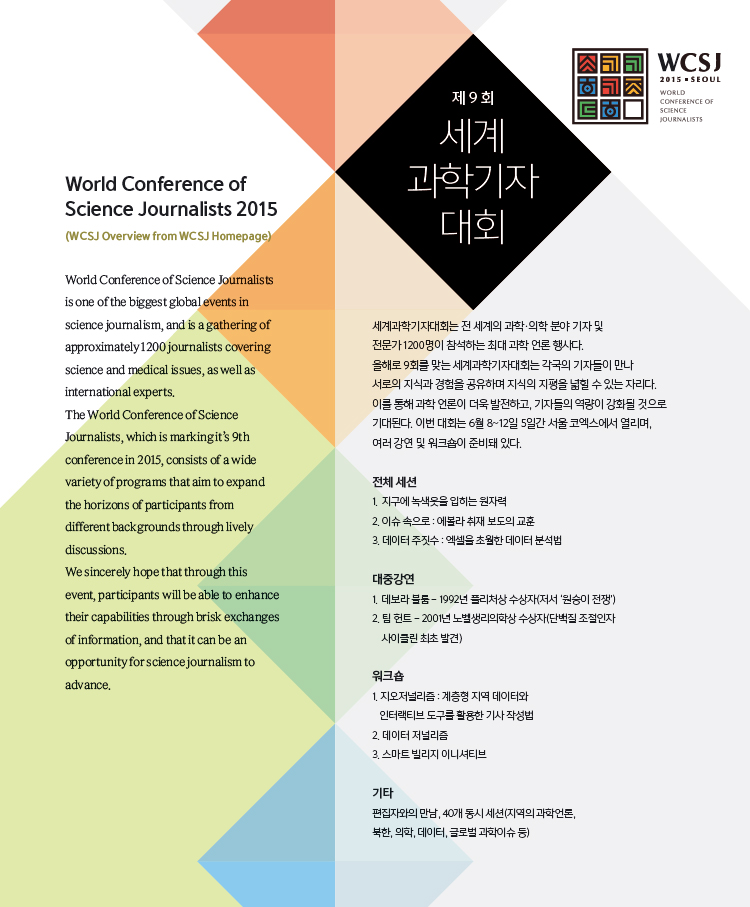
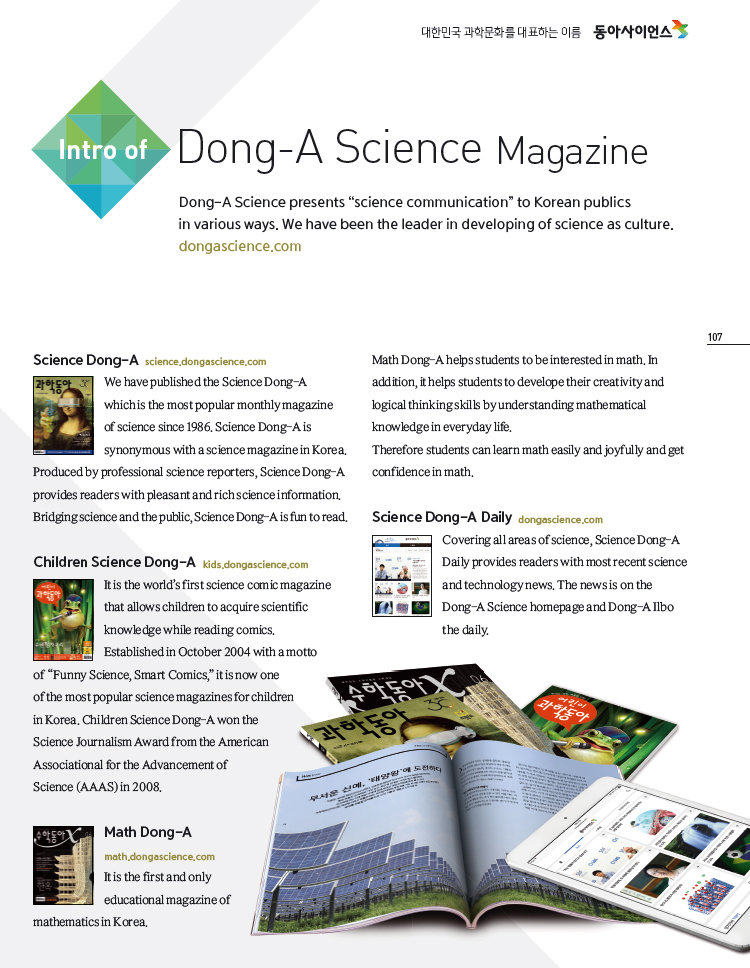
3. A dangerous volcano. Mt. Paektu, on the China-North Korea border, is revered in Korean history. But did you know that in the 10th century C.E., Paektu unleashed one of the biggest eruptions of the last 10,000 years? Why a volcano so far from the Ring of Fire would be so potent is a scientific mystery. In an unprecedented ongoing collaboration, North Korean and western scientists are trying to solve it.
Apart from the intrinsic fascination value of North Korea, one common thread of these aforementioned science stories is that none came from an embargoed press release. To say something new about these topics for your audience requires cultivating sources and seeking information that isn't served up on a silver platter. Being proactive in finding and breaking stories, as we all know, is the lifeblood of our profession.
Now for that challenge I mentioned. Come to the 9th World Conference of Science Journalists in Seoul in June, and make it your personal mission to learn something new. If North Korea fascinates you, come to a session about how science diplomacy is attempting to integrate North Korean scientists into the global scientific community. Or if you want to learn how journalists covered the Ebola outbreak in West Africa, we'll have a plenary panel featuring daring colleagues just back from the frontlines. We'll have keynote speakers who have won Nobel Prizes and Pulitzer Prizes. Other sessions will showcase pioneering scientists, many of them from South Korea, discussing their latest research findings. As chair of the Program Advisory Committee of WCSJ 2015, I guarantee you this: If you use your powers of observation at the conference, you will undoubtedly take home an insight ? or many insights ? that will make you a better journalist. Don't miss this chance.
article from KSJA newsletter







